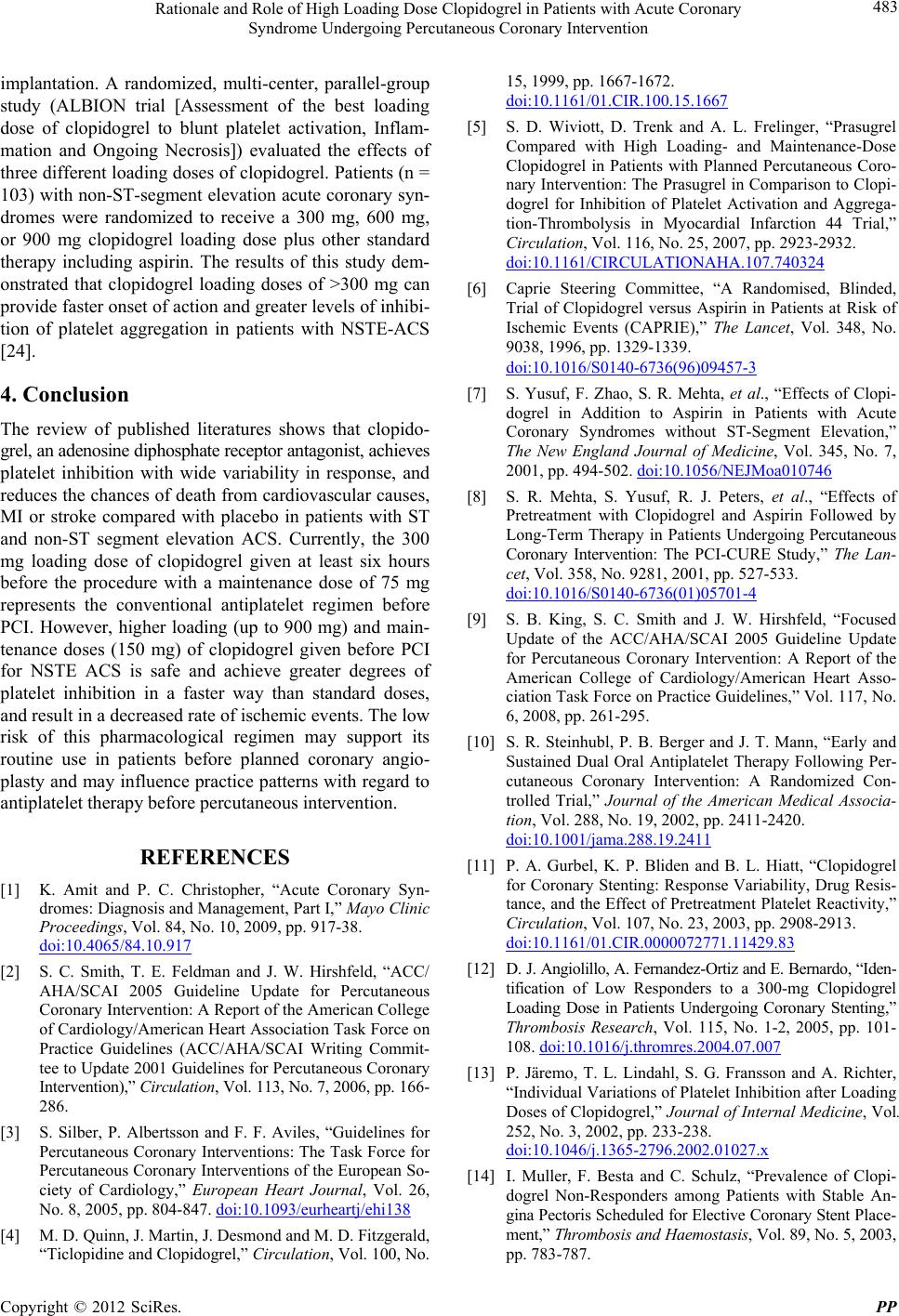
Rationale and Role of High Loading Dose Clopidogrel in Patients with Acute Coronary
Syndrome Undergoing Percutaneous Coronary Intervention 483
implantation. A randomized, multi-center, parallel-group
study (ALBION trial [Assessment of the best loading
dose of clopidogrel to blunt platelet activation, Inflam-
mation and Ongoing Necrosis]) evaluated the effects of
three different load ing doses of clopido grel. Patients (n =
103) with non-ST-segment elevation acute coronary syn-
dromes were randomized to receive a 300 mg, 600 mg,
or 900 mg clopidogrel loading dose plus other standard
therapy including aspirin. The results of this study dem-
onstrated that clopidogrel loading doses of >300 mg can
provide faster onset of action and greater levels of inhibi-
tion of platelet aggregation in patients with NSTE-ACS
[24].
4. Conclusion
The review of published literatures shows that clopido-
grel, an adenosine diphosphate recep tor antagon ist, ach ieves
platelet inhibition with wide variability in response, and
reduces the chances of death from cardiovascular causes,
MI or stroke compared with placebo in patients with ST
and non-ST segment elevation ACS. Currently, the 300
mg loading dose of clopidogrel given at least six hours
before the procedure with a maintenance dose of 75 mg
represents the conventional antiplatelet regimen before
PCI. However, higher loading (up to 900 mg) and main-
tenance doses (150 mg) of clopidogrel given before PCI
for NSTE ACS is safe and achieve greater degrees of
platelet inhibition in a faster way than standard doses,
and result in a decreased rate of ischemic events. The low
risk of this pharmacological regimen may support its
routine use in patients before planned coronary angio-
plasty and may influence practice patterns with regard to
antiplatelet therapy before percutaneous intervention.
REFERENCES
[1] K. Amit and P. C. Christopher, “Acute Coronary Syn-
dromes: Diagnosis and Management, Part I,” Mayo Clinic
Proceedings, Vol. 84, No. 10, 2009, pp. 917-38.
doi:10.4065/84.10.917
[2] S. C. Smith, T. E. Feldman and J. W. Hirshfeld, “ACC/
AHA/SCAI 2005 Guideline Update for Percutaneous
Coronary Intervention: A Report of the American College
of Cardiology/American Heart Association Task Force on
Practice Guidelines (ACC/AHA/SCAI Writing Commit-
tee to Update 2001 Guidelines for Percutaneous Coronary
Intervention),” C irculati on, Vol. 113, No. 7, 2006, pp. 166-
286.
[3] S. Silber, P. Albertsson and F. F. Aviles, “Guidelines for
Percutaneous Coronary Interventions: The Task Force for
Percutaneous Coronary Interventions of the European So-
ciety of Cardiology,” European Heart Journal, Vol. 26,
No. 8, 2005, pp. 804-847. doi:10.1093/eurheartj/ehi138
[4] M. D. Quinn, J. Martin, J. Desmond and M. D. Fitzgerald,
“Ticlopidine and Clopidogrel,” Circulation, Vol. 100, No.
15, 1999, pp. 1667-1672.
doi:10.1161/01.CIR.100.15.1667
[5] S. D. Wiviott, D. Trenk and A. L. Frelinger, “Prasugrel
Compared with High Loading- and Maintenance-Dose
Clopidogrel in Patients with Planned Percutaneous Coro-
nary Intervention: The Prasugrel in Comparison to Clopi-
dogrel for Inhibition of Platelet Activation and Aggrega-
tion-Thrombolysis in Myocardial Infarction 44 Trial,”
Circulation, Vol. 116, No. 25, 2007, pp. 2923-2932.
doi:10.1161/CIRCULATIONAHA.107.740324
[6] Caprie Steering Committee, “A Randomised, Blinded,
Trial of Clopidogrel versus Aspirin in Patients at Risk of
Ischemic Events (CAPRIE),” The Lancet, Vol. 348, No.
9038, 1996, pp. 1329-1339.
doi:10.1016/S0140-6736(96)09457-3
[7] S. Yusuf, F. Zhao, S. R. Mehta, et al., “Effects of Clopi-
dogrel in Addition to Aspirin in Patients with Acute
Coronary Syndromes without ST-Segment Elevation,”
The New England Journal of Medicine, Vol. 345, No. 7,
2001, pp. 494-502. doi:10.1056/NEJMoa010746
[8] S. R. Mehta, S. Yusuf, R. J. Peters, et al., “Effects of
Pretreatment with Clopidogrel and Aspirin Followed by
Long-Term Therapy in Patients Undergoing Percutaneous
Coronary Intervention: The PCI-CURE Study,” The Lan-
cet, Vol. 358, No. 9281, 2001, pp. 527-533.
doi:10.1016/S0140-6736(01)05701-4
[9] S. B. King, S. C. Smith and J. W. Hirshfeld, “Focused
Update of the ACC/AHA/SCAI 2005 Guideline Update
for Percutaneous Coronary Intervention: A Report of the
American College of Cardiology/American Heart Asso-
ciation Task Force on Practice Guidelines,” Vol. 117, No.
6, 2008, pp. 261-295.
[10] S. R. Steinhubl, P. B. Berger and J. T. Mann, “Early and
Sustained Dual Oral Antiplatelet Therapy Following Per-
cutaneous Coronary Intervention: A Randomized Con-
trolled Trial,” Journal of the American Medical Associa-
tion, Vol. 288, No. 19, 2002, pp. 2411-2420.
doi:10.1001/jama.288.19.2411
[11] P. A. Gurbel, K. P. Bliden and B. L. Hiatt, “Clopidogrel
for Coronary Stenting: Response Variability, Drug Resis-
tance, and the Effect of Pretreatment Platelet Reactivity,”
Circulation, Vol. 107, No. 23, 2003, pp. 2908-2913.
doi:10.1161/01.CIR.0000072771.11429.83
[12] D. J. Angioli llo, A. Ferna ndez- Ortiz and E. Be rnardo , “Iden-
tification of Low Responders to a 300-mg Clopidogrel
Loading Dose in Patients Undergoing Coronary Stenting,”
Thrombosis Research, Vol. 115, No. 1-2, 2005, pp. 101-
108. doi:10.1016/j.thromres.2004.07.007
[13] P. Järemo, T. L. Lindahl, S. G. Fransson and A. Richter,
“Individual Variations of Platelet Inhibition after Loading
Doses of Clopidogrel,” Journal of Internal Medicine, Vol.
252, No. 3, 2002, pp. 233-238.
doi:10.1046/j.1365-2796.2002.01027.x
[14] I. Muller, F. Besta and C. Schulz, “Prevalence of Clopi-
dogrel Non-Responders among Patients with Stable An-
gina Pectoris Scheduled for Elective Corona ry Stent P la ce-
ment,” Thrombosis and Haemostasis, Vol. 89, No. 5, 2003,
pp. 783-787.
Copyright © 2012 SciRes. PP